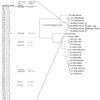Positively charged amino acid substitutions in the e2 envelope glycoprotein are associated with the emergence of venezuelan equine encephalitis virus
- PMID: 11799167
- PMCID: PMC135911
- DOI: 10.1128/jvi.76.4.1718-1730.2002
Positively charged amino acid substitutions in the e2 envelope glycoprotein are associated with the emergence of venezuelan equine encephalitis virus
Abstract
Epidemic-epizootic Venezuelan equine encephalitis (VEE) viruses (VEEV) have emerged repeatedly via convergent evolution from enzootic predecessors. However, previous sequence analyses have failed to identify common sets of nucleotide or amino acid substitutions associated with all emergence events. During 1993 and 1996, VEEV subtype IE epizootics occurred on the Pacific Coast of the states of Chiapas and Oaxaca in southern Mexico. Like other epizootic VEEV strains, when inoculated into guinea pigs and mice, the Mexican isolates were no more virulent than closely related enzootic strains, complicating genetic studies of VEE emergence. Complete genomic sequences of 4 of the Mexican strains were determined and compared to those of closely related enzootic subtype IE isolates from Guatemala. The epizootic viruses were less than 2% different at the nucleotide sequence level, and phylogenetic relationships confirmed that the equine-virulent Mexican strains probably evolved from enzootic progenitors on the Pacific Coast of Mexico or Guatemala. Of 35 amino acids that varied among the Guatemalan and Mexican isolates, only 8 were predicted phylogenetically to have accompanied the phenotypic change. One mutation at position 117 of the E2 envelope glycoprotein, involving replacement of Glu by Lys, resulted in a small-plaque phenotype characteristic of epizootic VEEV strains. Analysis of additional E2 sequences from representative enzootic and epizootic VEEV isolates implicated similar surface charge changes in the emergence of previous South American epizootic phenotypes, indicating that E2 mutations are probably important determinants of the equine-virulent phenotype and of VEE emergence. Maximum-likelihood analysis indicated that one change at E2 position 213 has been influenced by positive selection and convergent evolution of the epizootic phenotype.
Figures




References
-
- Bernard, K. A., W. B. Klimstra, and R. E. Johnston. 2000. Mutations in the E2 glycoprotein of Venezuelan equine encephalitis virus confer heparan sulfate interaction, low morbidity, and rapid clearance from blood of mice. Virology 276:93-103. - PubMed
-
- Brault, A. C., A. M. Powers, C. L. Chavez, R. N. Lopez, M. F. Cachon, L. F. Gutierrez, W. Kang, R. B. Tesh, R. E. Shope, and S. C. Weaver. 1999. Genetic and antigenic diversity among eastern equine encephalitis viruses from North, Central, and South America. Am. J. Trop. Med. Hyg. 61:579-586. - PubMed
-
- Calisher, C. H., and N. Karabatsos. 1988. Arbovirus serogroups: definition and geographic distribution, p. 19-57. In T. P. Monath (ed.), The arboviruses: epidemiology and ecology, vol. I. CRC Press, Boca Raton, Fla.
Publication types
MeSH terms
Substances
Associated data
- Actions
- Actions
- Actions
- Actions
- Actions
Grants and funding
LinkOut - more resources
Full Text Sources
Other Literature Sources
Molecular Biology Databases

